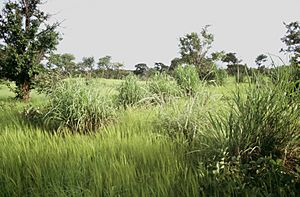Andropogon gayanus facts for kids
Quick facts for kids Andropogon gayanus |
|
|---|---|
 |
|
| Scientific classification | |
| Genus: |
Andropogon
|
| Species: |
gayanus
|
Andropogon gayanus, often called gamba grass, is a type of tall grass. It's also known by other names like Rhodesian blue grass. This grass originally comes from the warm, grassy areas of Africa, called savannas.
Contents
What is Gamba Grass?
Gamba grass was first identified and named by scientists around 1833. It has many common names, depending on where you are. Some of these include bluestem, Rhodesian blue grass, and tambuki grass.
How Does it Look and Grow?
This grass grows in clumps, like a big bush. It can reach up to 4 meters (about 13 feet) tall and 70 centimeters (about 2.3 feet) wide. Its leaves are a bit hairy.
Most of its roots stay close to the ground, spreading out about 1 meter (3 feet). But it also has thicker roots that store food and help anchor the plant. Some roots even go deep to find water during dry times.
Gamba grass makes a lot of light, fluffy seeds. A single plant can produce up to 244,000 seeds each year! About 65% of these seeds can grow into new plants. These seeds can be carried by wind, animals, or even farm machinery. It spreads quickly in areas where the ground has been disturbed. However, most seeds usually fall within 5 meters (16 feet) of the parent plant.
Where Does it Live?
Gamba grass is native to most of the tropical and subtropical savannas in Africa. You can find it in countries like Mozambique, Botswana, Namibia, and South Africa. It grows well in dry grasslands, even on different types of soil like sandy or clay soils. It can grow at heights up to 1,500 meters (about 4,900 feet) and can handle very dry conditions. However, it doesn't like cold weather and cannot survive frost.
People have introduced gamba grass to many other parts of the world. This includes tropical countries in the Americas, where it has started to grow naturally, like in Brazil. It was mainly brought to these places to be used as a good plant for pasture (where animals graze).
For example, gamba grass was brought to the Northern Territory of Australia in 1931. It was tested there as food for cattle. Later, in 1942, it was imported into Queensland, Australia, for the same reason. However, it wasn't widely planted until about 1983. In Queensland, it mostly grows in areas below 980 meters (about 3,200 feet) that get 400 to 1500 millimeters (16 to 59 inches) of rain each year.
What is it Used For?
Gamba grass is used in several ways:
- Cattle Food: It is a popular pasture crop for cattle in many countries. This includes areas like far north Queensland in Australia.
- Land Repair: In Nigeria, it has been used to help fix land that has been overgrazed by animals.
- Soil Protection: Planting strips of gamba grass in fields can help stop wind from blowing away the soil. This is called wind erosion.
- Building Material: In some African countries, the strong stems of the grass are used as thatch for roofs.
Why is it a Problem?
In Australia, gamba grass has become a big problem. Since 2012, it has been officially called a "Weed of national significance." This means it's a very serious weed that needs to be controlled across the country.
Here's why it's a problem:
- Outcompetes Native Plants: It grows in thick patches, taking over areas and pushing out native plant species. This changes the natural ecosystems.
- Fire Risk: Areas with a lot of gamba grass have a much higher risk of intense fires. If the grass isn't eaten by animals, its clumps can create very hot fires. These fires can destroy trees and cause long-term damage to the environment.
- Resistant to Control: Gamba grass is very tough. It's hard to get rid of by cutting or burning.
- Loss of Biodiversity: Because it replaces native grasses, it reduces the natural variety of life (called biodiversity) in untouched areas.
- Spreads Easily: It can quickly move into protected nature areas, suburban lands, and even mining sites.
In Australia's Northern Territory, where there are huge amounts of gamba grass, it's seen as a "triple threat." It threatens people's lives, the local economy, and could destroy the unique northern savanna.
How is it Controlled?
States like Western Australia (WA), the Northern Territory (NT), and Queensland have laws against planting new gamba grass. These laws also require land managers to control existing infestations.
One interesting idea came from a professor in 2013. He suggested bringing African elephants to Australia to eat the gamba grass. This would be a trial to see if using large animals could help control the weed.
In Western Australia, where the problem wasn't as bad, they started the Gamba Grass Eradication Program in 2011. This project involves different government departments and local groups. It has been very successful! They reduced the number of plants from many to just 3,000 by 2018, and only 23 by 2020. In 2021, they found only eight plants. Even though it's been successful, they still need to monitor the area for five more years to make sure it doesn't spread again.

